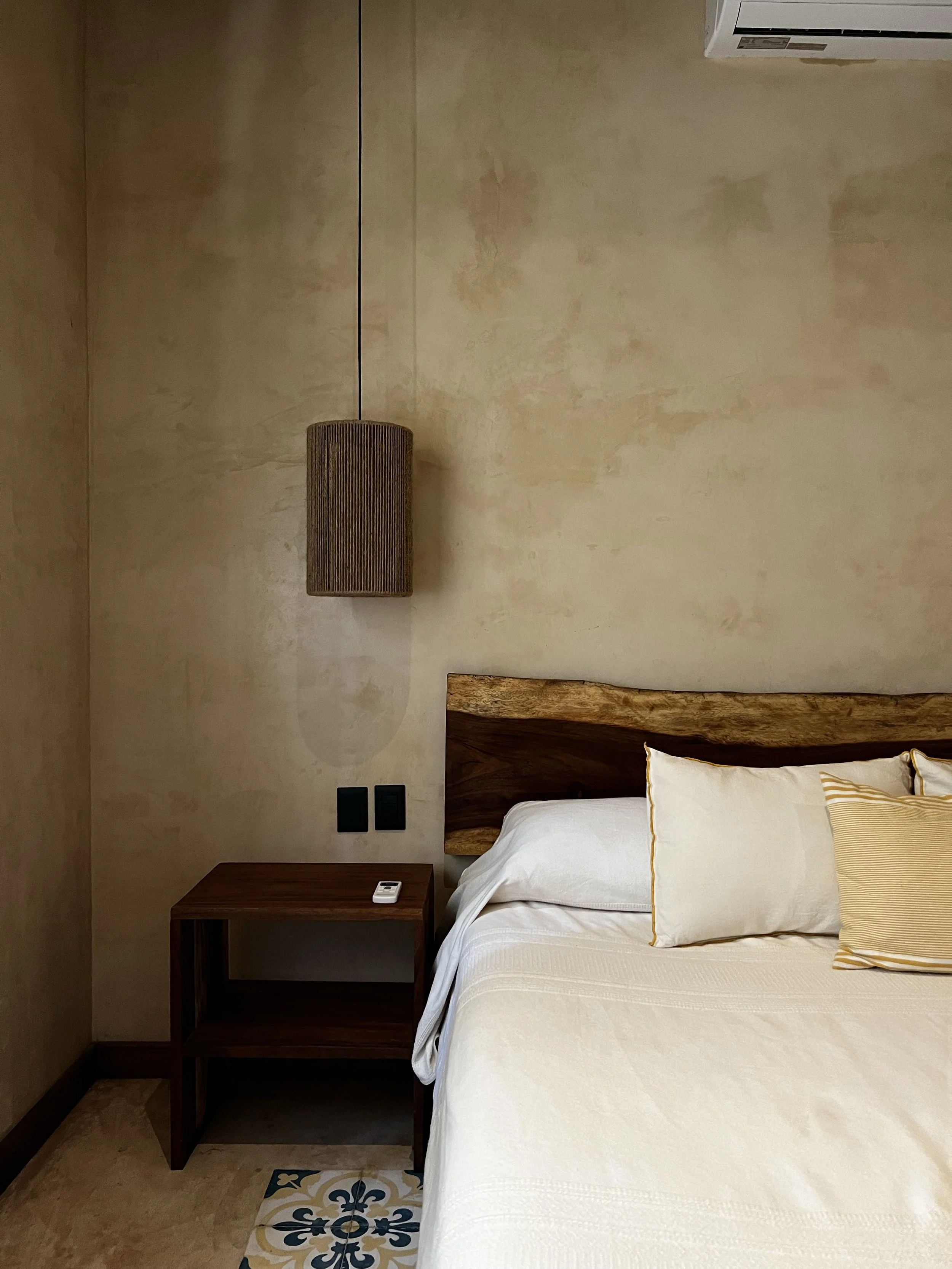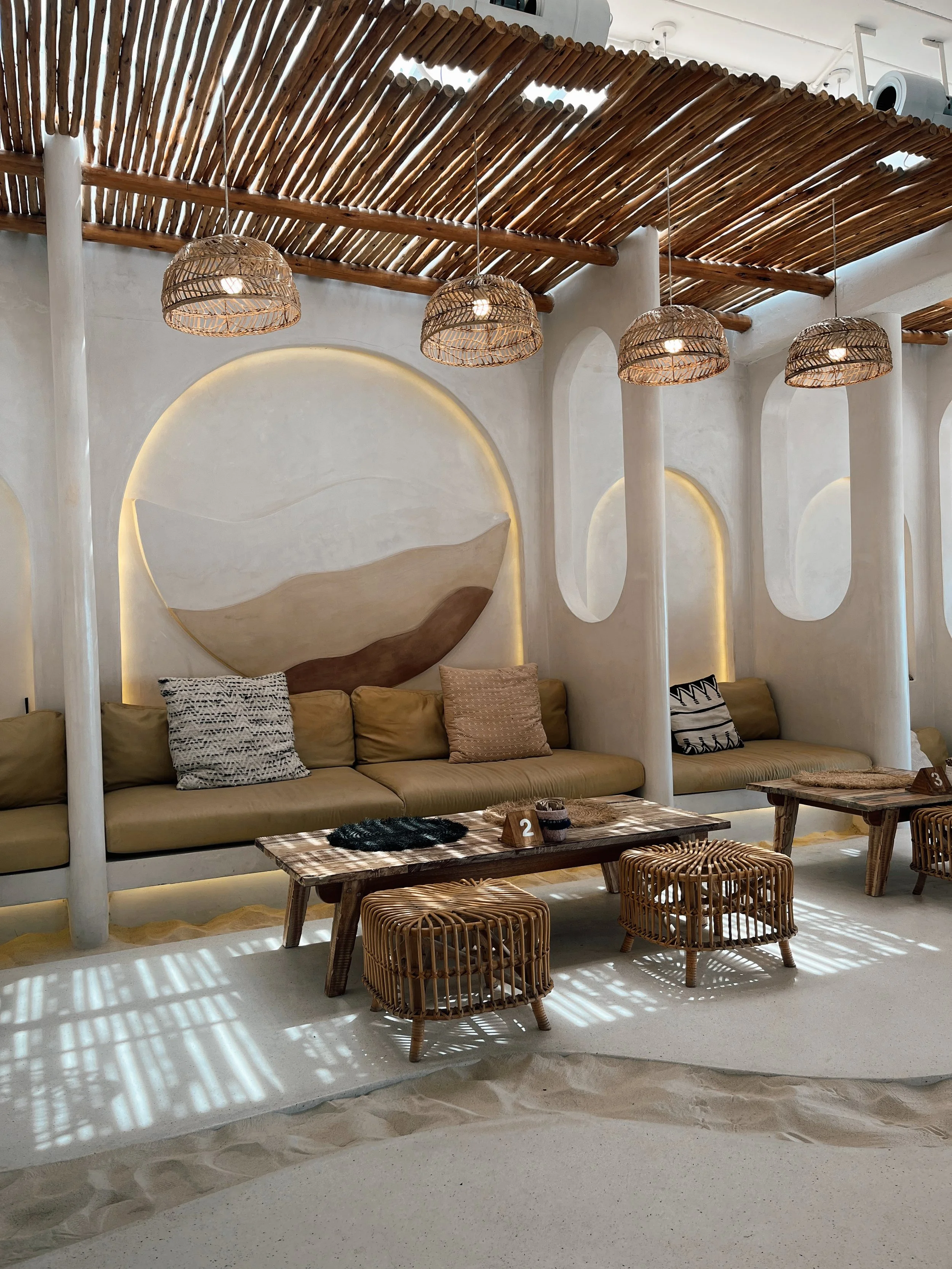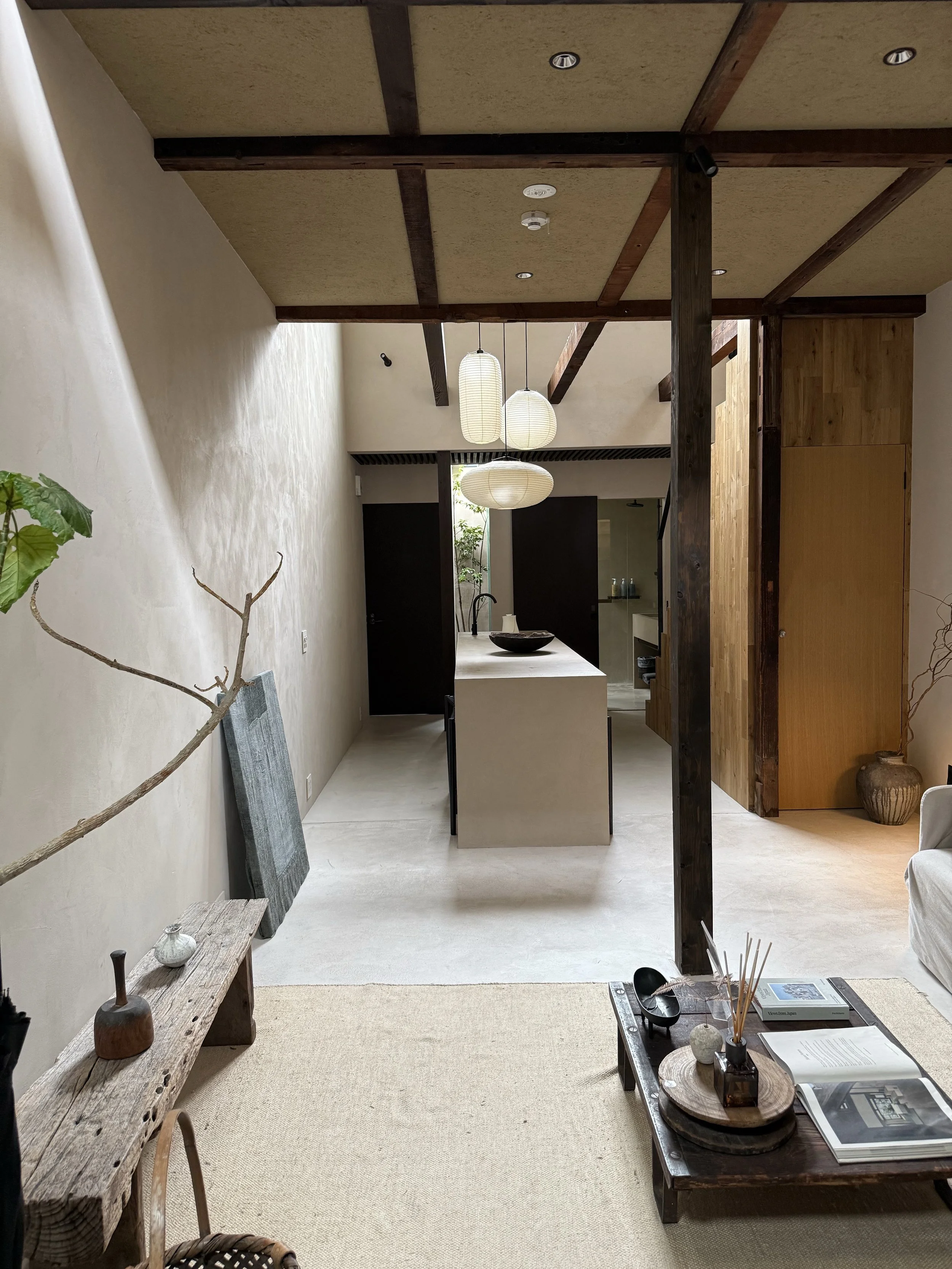Slow Interiors: The Art of Living Lightly, Deeply, and Beautifully
by azulomo | 6 min read
Soulful, slow style
Slow Interiors: Style Meets Stillness
Step into a slow interior and you’ll feel it before you see it. The quiet. The space to breathe. The sense that everything—every texture, every tone, every object—has earned its place not through trend, but through care. In a world obsessed with fast transformations and flashy aesthetics, slow interiors offer something softer, richer, and far more enduring.
This isn’t just a design trend. It’s a mindset. A return to what matters. And for those creating vacation homes, boutique stays, or simply sanctuaries for the soul—slow interiors are the calm beneath the chaos. They invite you to pause. To notice how morning light dances across a textured wall, or how a simple wooden chair can feel like an anchor in a world of motion. These spaces aren’t about perfection—they’re about presence. They hold the patina of time, the fingerprints of story, and the quiet confidence of design that’s meant to last.
In vacation homes and boutique stays, slow interiors do more than look beautiful—they help guests feel grounded. They soften arrivals. They transform short visits into meaningful experiences. And for hosts, they offer a new kind of luxury: one built not on opulence, but on care, character, and considered calm.
Slow interiors speak in whispers, not trends. They remind us that comfort isn’t a cushion—it’s a feeling, with soul and simplicity.
What Are Slow Interiors, Really?
Slow interiors aren’t about trends. They’re about tempo. They offer an intentional shift away from overconsumption, speed, and perfectionism—inviting us to design with care, not urgency. Where conventional interiors often aim for instant impact, slow interiors are built gradually, layer by layer, over time. They’re curated with presence. And the result? Homes that feel deeply personal, emotionally grounded, and quietly alive.
Rather than filling a room for the sake of completion, slow design asks: What truly belongs here? The answer unfolds through thoughtful decisions—choosing natural materials that patinate with age, embracing neutral and earthy colour palettes, blending tactile textures, sourcing vintage or artisan pieces with story, and allowing space—real, open space—for stillness to exist.
A slow interior doesn’t shout for attention. It whispers with warmth. It tells stories through the scuff of a chair, the softness of handwoven linen, the flicker of candlelight on limewashed walls. It creates room not just to live, but to breathe. And for guests, it doesn’t perform—it holds. It lets them arrive, exhale, and just be.
Slow design isn’t anti-style. It simply believes that style and soul should walk hand in hand.
The Feeling of a Slow Interior
If a slow interior had a soundtrack, it wouldn’t be grand orchestral music—it would be the gentle hum of light through linen, the creak of floorboards under bare feet, the soft clink of handmade ceramic mugs. These spaces don’t just look good—they feel good. They evoke that quiet sigh you didn’t know you were holding. That sensation of exhaling into comfort. That almost imperceptible “ahh” when you step into a room and your shoulders finally drop.
It’s the hush of raw linen curtains stirring in a salty breeze. The grounding coolness of terracotta tiles underfoot. The muted palette that eases your nervous system without asking for applause. It’s the smell of beeswax, the dim glow of a lamp in early evening, the presence of time worn well.
Slow interiors aren’t static. They breathe with you. They change with the light and the seasons. They give back energy rather than demand it. And for hosts, this approach isn’t about impressing—it’s about soothing, nourishing, and creating connection through quiet details.
Why Slow Interiors Are Taking Root
The slow design movement is gaining real ground—not just in homes, but in vacation rentals, boutique hotels, and creative stays across Europe and beyond. It speaks to a deeper cultural need: the desire to disconnect from noise and reconnect with what truly matters. After a decade of sensory overload, perfectly staged Instagram homes, and disposable furniture, many are simply craving more soul.
And the data backs it up. Google Trends has shown a steady rise in searches for “slow interiors” and “slow living” since 2020. On TikTok, the hashtag #slowliving has soared past 500 million views, filled with calming home rituals and unhurried aesthetics. According to The Furniture Recycling Group, over 22 million items of furniture are thrown away in the UK every year—fueling a collective backlash against wasteful consumption. Meanwhile, Storage World UK found that 79% of Brits feel overwhelmed by clutter, linking well-designed, thoughtful interiors to improved mental health and emotional clarity.
This is more than a passing aesthetic. It’s a real, felt shift. A lifestyle choice. And a design philosophy that attracts homeowners, hosts, and guests alike.
Who’s Embracing the Slow Movement?
The slow interiors movement is resonating with a wide audience—but some groups are embracing it with particular fervour.
Millennials and Gen Z are leading the charge. Raised in a world of fast everything, they’re pivoting towards slower, more meaningful living. Eco-conscious and emotionally tuned in, they’re investing in fewer, better things—opting for vintage markets, natural fibres, and handmade pieces that align with their values.
Soulful hosts and design-led creatives are also taking note. From Comporta to Cornwall, boutique vacation rentals are using slow interiors to stand out in a saturated market. By styling spaces with softness, story, and sensory detail, they’re offering not just a stay—but a feeling.
Then there are wellbeing-first homeowners—those seeking calm, nervous-system-regulating spaces that feel like sanctuary. For them, slow interiors are a form of self-care. A gentle rebellion against urgency. A space to come back to themselves.
For all of them, slow isn’t just a design decision. It’s a new way of being.
The Soul of Slow: Defining Features
So what makes a slow interior truly sing? It’s not a checklist—it’s a language. But some recurring notes strike a consistent chord.
It begins with materials. Wood, stone, linen, wool, clay—natural elements that ground a space in the rhythms of the earth. These materials don’t just decorate, they anchor. They soften the senses and grow more beautiful with time.
Then there’s wabi-sabi—the Japanese philosophy that honours the imperfect, the unfinished, and the gracefully weathered. A chipped bowl, a scuffed chair, a hand-plastered wall—they’re not flaws. They’re the fingerprints of life being lived well.
Texture is key. Sensory layering brings emotional depth. Think woven rugs, buttery upholstery, chalky finishes, and thick wool throws—textures that beg to be touched. Colour, too, takes a softer route. Slow interiors favour palettes that soothe rather than shout: warm whites, putty greys, olive greens, ochres, terracotta tones. They hum instead of buzz.
And finally, there’s the gift of space. Not everything must be filled. Slow interiors understand the beauty of absence. They leave breathing room—for light, for quiet, for reflection. For a moment to just sit, in a chair by the window, doing nothing at all.
Brands and Publications That Embody Slow Interiors
When seeking inspiration for this way of designing and living, it helps to follow those already walking the path with grace.
British lifestyle brand TOAST is a frontrunner in the world of slow interiors—championing artisan craftsmanship, natural fibres, and products that feel like they belong in a sun-drenched reading nook. Frama Copenhagen brings a Scandinavian calm to furniture and homeware, crafting sculptural pieces with soul. Skagerak designs beautiful Nordic furniture with sustainability and legacy in mind—pieces you keep, cherish, and pass on. Even Zara Home has quietly aligned with this aesthetic in recent collections, with textured ceramics, muted linens, and rustic simplicity seeping through the mainstream.
For visual nourishment, Kinfolk remains the gentle guidebook of slow living. With its serene pages and soft focus, it celebrates homes that tell stories, not trends. Cereal brings a more architectural take—perfect for those who seek elegance in restraint. Apartamento offers a beautiful, imperfect antidote—homes filled with colour, character, and the messy magic of real life. The Kinfolk Home (book) and The New Era Magazine further explore this world, honouring Scandinavian sensibilities, sustainable architecture, and thoughtful design.
These creators, curators, and storytellers aren’t just selling aesthetics. They’re offering presence. Meaning. Peace.
—
One Wave at a Time
At azulomo, we believe your home—or your guest space—can be more than a backdrop. It can be a balm. A retreat. A space that breathes with you, that reminds you to slow down, and that gently restores everyone who walks through its door.
Slow interiors invite you to decorate like you live: with intention, curiosity, and care. To embrace patience. To tell stories through every detail. And to trust that the most beautiful spaces are the ones that evolve with you—softly, slowly, one wave at a time.
Whether you're curating your own calm retreat or crafting a guest experience rooted in feeling, remember: you don’t need to rush. You don’t need to perfect. Just begin.
The rest will unfold—beautifully, and in its own time.
“Slow interiors are more than a design choice—they’re a shift in mindset. Rooted in warmth, texture, and intention, they invite us to live—and host—with meaning. In a world full of noise, this is a quiet kind of beauty. One that doesn’t date, but deepens.”






